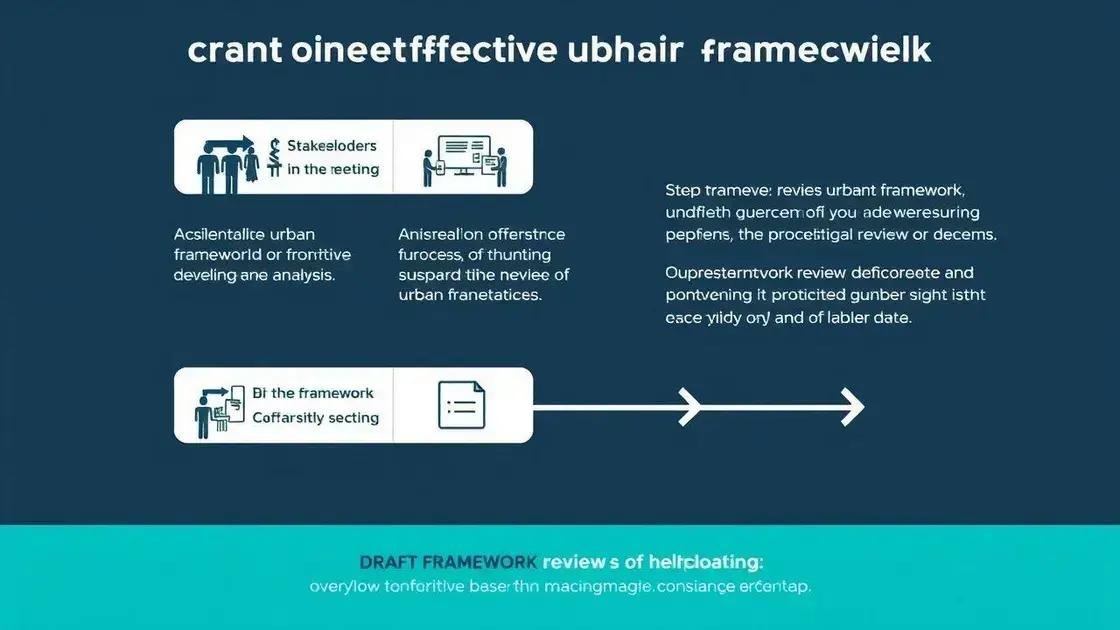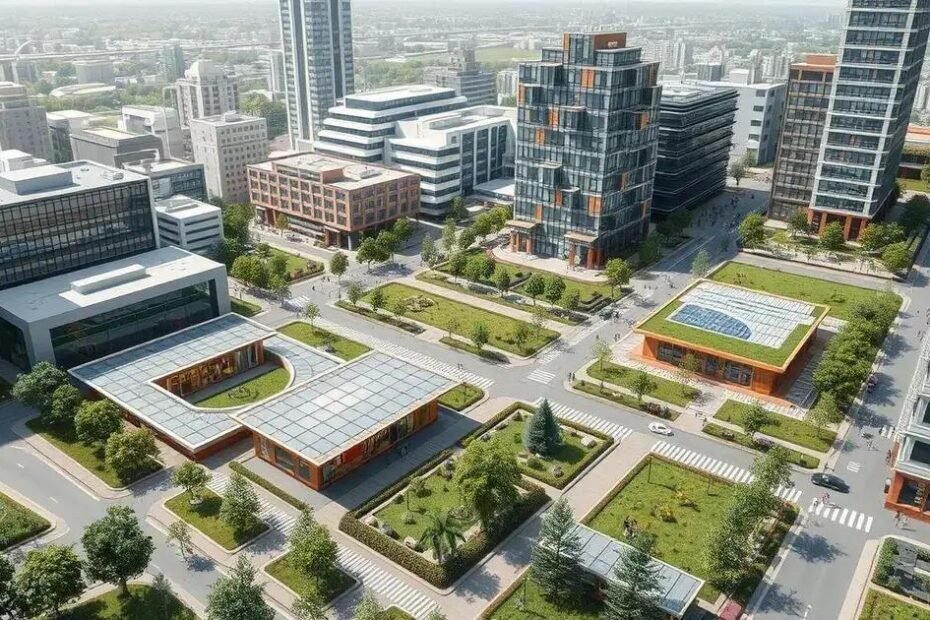Strategic frameworks for urban demonstration zones optimize urban planning by promoting innovation, sustainability, and community engagement, ensuring that solutions effectively address real-world challenges in urban environments.
Strategic frameworks for urban demonstration zones represent a vital approach to tackling urban challenges. By examining successful models, we can identify innovative solutions that resonate with local communities. Ready to explore actionable strategies? Let’s dive in!
Understanding urban demonstration zones
Understanding urban demonstration zones is essential for addressing contemporary urban challenges. These zones serve as testing grounds for innovative solutions in cities, allowing planners and communities to experiment with new ideas before wider implementation. The flexibility of these zones facilitates collaboration between local governments, businesses, and citizens.
In an urban demonstration zone, various strategies can be tested to enhance city living. Planners can create spaces that prioritize sustainability, inclusivity, and technology. By analyzing the outcomes, stakeholders can refine their approaches and apply successful models to broader areas.
Key Features of Urban Demonstration Zones
Several characteristics define effective urban demonstration zones:
- Innovation Labs: Spaces dedicated to testing new ideas and technologies.
- Community Engagement: Active involvement of local residents in decision-making.
- Partnerships: Collaborations between public and private sectors to share resources and expertise.
- Flexibility: The ability to adapt projects based on feedback and results.
Urban demonstration zones often incorporate green spaces and public art to enhance community involvement. For instance, a park designed within a demo zone might include eco-friendly landscaping and interactive art installations. These elements not only beautify the area but also foster a sense of belonging among residents.
Benefits of Urban Demonstration Zones
Implementing these zones comes with significant advantages:
- Testing New Policies: Allows for real-world evaluation of policies before city-wide application.
- Attracting Investment: Demonstrating innovative projects can draw funding from various sources.
- Community Resilience: Encourages local solutions to urban problems, enhancing adaptability.
In summary, urban demonstration zones represent a forward-thinking approach to urban planning and development. They help cities respond to changing needs while promoting collaboration and innovation.
Key benefits of strategic frameworks
Key benefits of strategic frameworks play a crucial role in the planning and execution of urban demonstration zones. By establishing a clear direction, these frameworks help cities to optimize resources and foster innovation.
One major benefit is enhanced collaboration among stakeholders. When all parties are aligned and understand their roles, it leads to more effective problem-solving. This collaboration increases accountability and reduces misunderstandings, thus streamlining processes.
Advantages of Using Strategic Frameworks
Several advantages are associated with implementing strategic frameworks:
- Clarity of Goals: They provide a well-defined vision for the urban demonstration zone.
- Resource Efficiency: Efficient use of resources reduces waste and maximizes impact.
- Data-Driven Decisions: Frameworks emphasize the use of data to guide planning and evaluation.
- Community Engagement: These frameworks encourage involvement from local communities, fostering a strong sense of ownership.
Another key benefit is the adaptability of strategic frameworks. By focusing on iterative improvements, cities can adjust their approaches based on feedback and changing conditions. This flexibility allows for real-time adjustments, ensuring the success of the demonstration zones.
Building Stronger Communities
Strategic frameworks not only guide projects but also strengthen community ties. Involving residents in developing these frameworks nurtures a culture of shared responsibility. Furthermore, it empowers communities to voice their needs, ensuring that the solutions developed are relevant and effective.
By leveraging strategic frameworks, urban demonstration zones can become powerful catalysts for change. This proactive approach leads to sustainable urban development, improving the quality of life for residents.
Steps to develop an effective framework

Steps to develop an effective framework are essential for creating successful urban demonstration zones. These steps provide a structured approach that can guide cities in their planning and implementation.
First, it is crucial to identify the specific goals of the urban demonstration zone. By clarifying what the zone aims to achieve, stakeholders can align their efforts more effectively. Goals might include enhancing sustainability, promoting community engagement, or testing new technologies.
Gathering Stakeholder Input
Engaging with stakeholders is a key step in developing the framework. This engagement opens the door for valuable insights and fosters collaboration. Consider including:
- Local government representatives.
- Community members and local organizations.
- Businesses and investors.
- Urban planners and architects.
Next, assess existing conditions within the urban area. Understanding the current landscape helps to identify challenges and opportunities. Analyzing data such as demographics, infrastructure, and environmental factors can guide decision-making.
Drafting the Framework
Once objectives and input are gathered, it’s time to draft the strategic framework. This draft should outline specific actions, timelines, and responsibilities to ensure clarity. Incorporating feedback from stakeholders at this stage is critical, as it helps to refine the framework and ensure it meets community needs.
Testing the framework is another important step. By implementing pilot projects within the demonstration zone, planners can gather real-world data to evaluate effectiveness. This iterative process allows for adjustments based on feedback and outcomes, improving the overall approach.
Finally, regular reviews of the framework help maintain its relevance. By continuously assessing progress and adapting to new challenges, cities can ensure that their demonstration zones remain effective catalysts for innovation.
Case studies of successful implementations
Case studies of successful implementations highlight the effectiveness of strategic frameworks in urban demonstration zones. These examples provide valuable insights into how cities have tackled challenges and achieved their goals.
One notable case is the city of Barcelona, which launched its smart city initiative. Utilizing a framework focused on digital innovation, Barcelona integrated technology into urban infrastructure. This included smart lighting, waste management systems, and efficient public transportation. The community benefited through enhanced connectivity and improved quality of life.
Portland’s Green Roof Initiative
Another example comes from Portland, Oregon. The city adopted a strategic framework aimed at increasing green spaces through its Green Roof Initiative. This framework outlines specific actions to promote sustainability and improve urban biodiversity. It involved:
- Incentives for building green roofs.
- Community education programs about the benefits of green spaces.
- Collaborations with local businesses for funding and expertise.
As a result, Portland saw an increase in green infrastructure, which helped reduce urban heat and improve air quality.
Melbourne’s Urban Forest Strategy
Melbourne, Australia, implemented its Urban Forest Strategy. This strategic framework focuses on expanding tree canopies throughout the city. The initiative aims to provide shade, enhance aesthetics, and support biodiversity. Key components of this framework include:
- Mapping existing tree coverage.
- Engaging residents in tree planting events.
- Monitoring tree health and growth annually.
The strategy effectively boosted public participation and improved environmental outcomes, showcasing the power of community involvement in urban planning.
These case studies exemplify how effective frameworks can lead to innovative solutions in urban demonstration zones. By learning from these examples, other cities can adapt strategies to suit their unique challenges.
Future trends in urban planning
Future trends in urban planning indicate a shift towards more sustainable and resilient cities. As urban areas continue to grow, planners are focusing on innovations that improve quality of life while protecting the environment.
One key trend is the rise of smart cities. These urban environments leverage technology to enhance the efficiency of services. For instance, smart sensors can monitor traffic patterns and adjust signals accordingly, reducing congestion. This integration of technology helps cities respond quickly to changing needs.
Sustainable Design Practices
Sustainable design is becoming a central theme in urban planning. Developers are increasingly using eco-friendly materials and practices to minimize environmental impact. Strategies such as:
- Green building certifications to encourage energy efficiency.
- Urban agriculture initiatives that promote local food production.
- Rainwater harvesting systems to conserve water.
- Integrating natural landscapes into urban spaces to enhance biodiversity.
These practices not only conserve resources but also create healthier living environments.
Community-Centric Approaches
An important focus in future urban planning is community engagement. Cities are moving towards a more participatory approach, involving residents in decision-making. By gathering input from diverse groups, planners can develop solutions that truly reflect community needs. This trend fosters a sense of ownership among residents and leads to more successful outcomes.
Additionally, mixed-use developments are gaining popularity. These projects combine residential, commercial, and recreational spaces in one area, promoting walkability and reducing reliance on cars. They create vibrant neighborhoods where people can live, work, and play.
As cities evolve, integrating resilience into planning frameworks is essential. This means designing urban areas that can adapt to climate change and other challenges. Strategies include enhancing public transportation, improving green spaces, and investing in infrastructure that can withstand extreme weather.
Conclusion: The future of urban planning is bright, focusing on innovation, sustainability, and community engagement. Cities are embracing smart technologies and eco-friendly practices to create better living environments. By involving residents in the planning process, cities reflect the needs of their communities. Sustainability is a priority as urban areas adapt to climate change. As these trends develop, urban demonstration zones will serve as catalysts for change, guiding cities toward a more sustainable and livable future.
FAQ – Frequently Asked Questions about Urban Demonstration Zones
What are urban demonstration zones?
Urban demonstration zones are areas where new ideas and strategies for urban development can be tested and evaluated before wider implementation.
Why is community engagement important in urban planning?
Community engagement ensures that the diverse needs and preferences of residents are considered, leading to more effective and accepted urban solutions.
How do smart technologies enhance urban living?
Smart technologies, such as sensors and data analytics, improve the efficiency of services, reduce traffic congestion, and enhance overall quality of life in urban areas.
What role does sustainability play in urban planning?
Sustainability focuses on using eco-friendly practices and innovations to create resilient urban environments that can adapt to climate change and other challenges.

